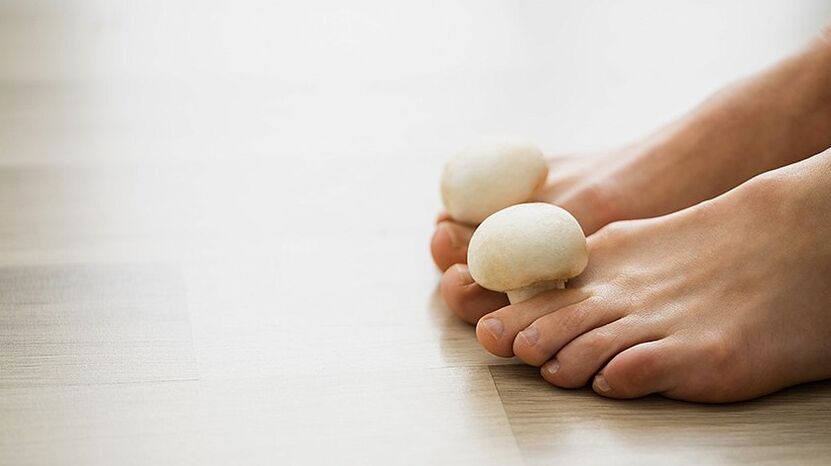
Onychomycosis, commonly known as onychomycosis, is a condition in which the nail plate and surrounding structures are damaged by a fungal infection. Nails infected with fungus change color and transparency, become brittle, rough, thickened, peel and crumble. In this case, the tissue under or near the nail may become red and swollen.
Nail fungus is a very common condition. According to statistics, nail fungus affects from 8 to 26. 9% of the population worldwide, and in Russia the number of people with this disease ranges from 4. 5 to 15 million people.
Most often, onychomycosis is found in patients over 40 years old. At the same time, there are no unified statistics on the frequency of disease occurrence in men and women, and the opinions of the authors differ. In Russia, nail fungus is common in men. At the same time, women are one and a half times more likely to visit a doctor - perhaps this is explained by a more attentive attitude to the health and appearance of nails on their feet and hands. The photos may be shocking.
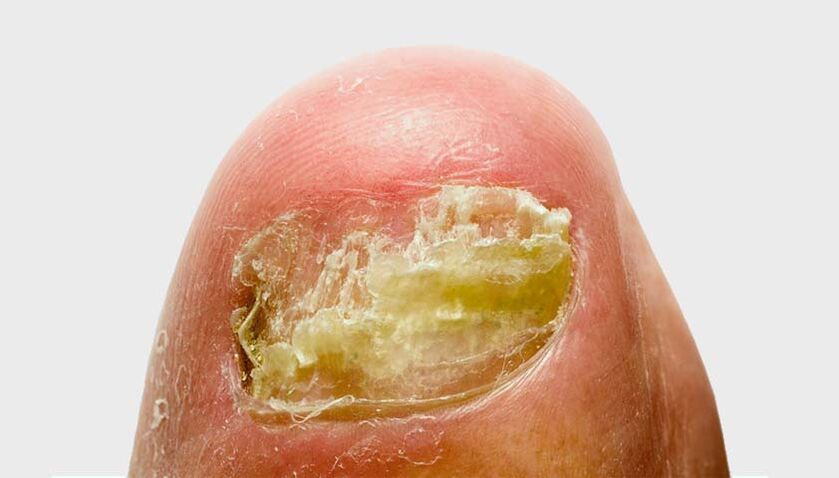
In about 80% of cases, the disease affects the toenails. Less commonly, onychomycosis affects the nails. Researchers have identified factors that significantly increase the risk of developing onychomycosis. They can be roughly divided into two groups.
External (exogenous) risk factors for the development of onychomycosis:
- nail trauma;
- wearing tight, non-ventilated shoes for long periods of time;
- live in a hot and humid climate.
Internal (endogenous) risk factors for the development of onychomycosis:
- Patient age: the disease is common in people over 40 years old;
- overweight;
- reduced immunity;
- Related diseases: diabetes, thyroid disease, varicose veins;
- flat feet and other foot deformities;
- Long-term use of certain drugs: antibiotics, cytostatics, corticosteroids.
Family factors play a special role in the spread of onychomycosis. According to statistics, 55% of patients have a family history of nail fungus.
You can get infected with nail fungus through direct contact with an infected person, as well as through household items - clothes, shoes, hygiene products (washcloths, towels).
In public places, infections occur mainly in gyms, bathhouses, saunas and swimming pools. Scales containing disease-causing fungi collect on floors, benches, walkways and screens. Fungi in such conditions continue to multiply and soon find a new host.

The fungus that causes onychomycosis reproduces well in high humidity conditions. In addition, you can get nail fungus in a manicure or pedicure salon if the owner does not comply with the rules of hygiene and disinfection of tools.
Causes of nail fungus
About 50 species of fungi are known to infect the nail plate. At the same time, dermatophytes of the genus Trichophyton account for up to 80–90% of cases of onychomycosis of the feet and up to 36% of cases of onychomycosis of the hands.
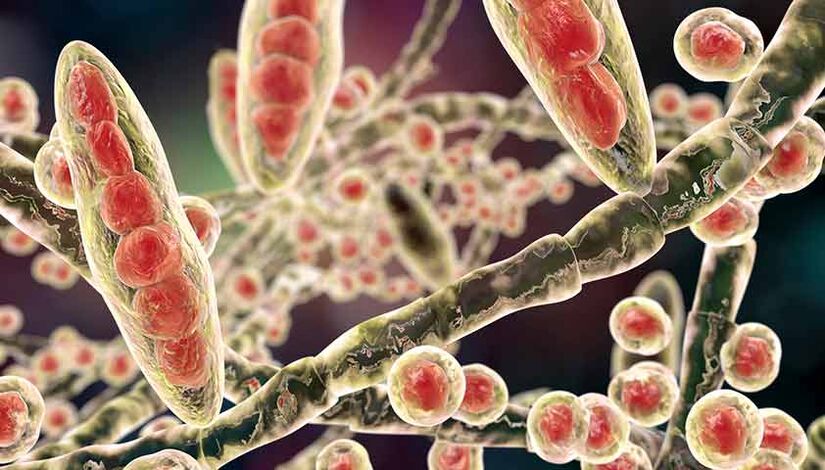
Dermatomycetes are microscopic fungi that attack the skin, hair, and nails. The second most common causative agent of onychomycosis is yeast of the genus Candida (candida). Nail candidiasis occurs in 5–10% of cases. Less common pathogens of onychomycosis are mold - Aspergillus (Aspergillus), Fusarium (Fusarium), Scopulariopsis (Spculariopsis).
In fact, the nail plate is damaged by many types of fungi at the same time. Usually this is a combination of two types of dermatomycetes or variations of "dermatomycetes + yeast", "dermatomycetes + Mold". In about 10% of cases, patients are infected with three or more types of fungi.
Types of nail fungus
In Russian dermatology, three types of onychomycosis are distinguished, depending on the clinical manifestations of the disease.
The main types of nail fungus:
- normal: the shape of the nail plate does not change, while in the thickness of the nail white and yellowish stripes are visible;
- hypertrophy: the nail plate thickens significantly, becomes brittle, has jagged edges;
- dystrophy: the nail plate becomes thinner and detaches from the nail bed.
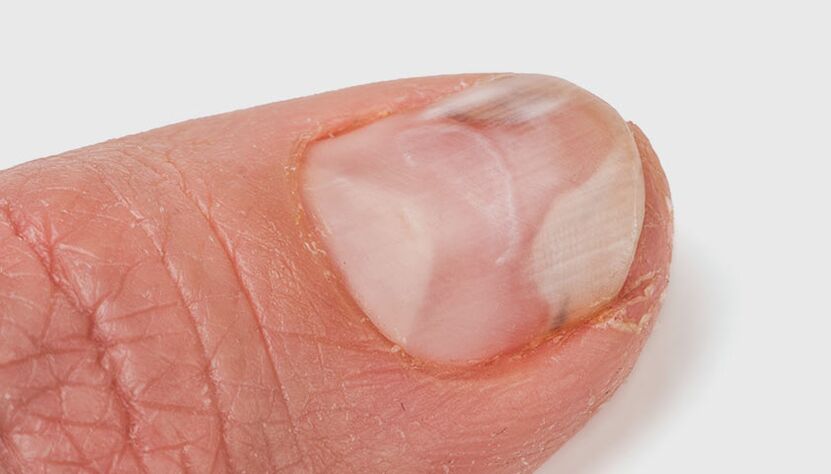
Depending on how the fungus enters the skin and nails, there are four types of onychomycosis.
Types of fungal nail diseases depend on the location of penetration and spread of the pathogenic fungus on the nail plate:
- white appearance: the fungus invades the upper part of the nail plate. White lesions appear on the nails. As the infection spreads, the nail turns gray-brown and begins to crumble;
- under the distal nail: the fungus penetrates the skin in the nail fold area or the free edge of the nail. The nail plate thickens, turns yellow, crumbles, then moves away from the nail bed;
- near under the nail: the fungus spreads from the skin and nail folds to the nail plate and deeper. Spots appear on the nail in the area of the hole and nail bed. The nail plate peels off;
- Total dystrophy: the entire nail plate is affected. It looks dense and has a dirty yellow color. The nail surface becomes uneven.
Once on the nail plate or surrounding structures, the fungal colony begins to grow towards the matrix - the growth zone located behind the nail bed. It is believed that the faster the nail grows, the more effectively it displaces the fungal population and the faster the onychomycosis recovers. This mechanism also explains the fact that nail fungus mainly affects people over 40 years old: their nails grow much slower than those of young people.
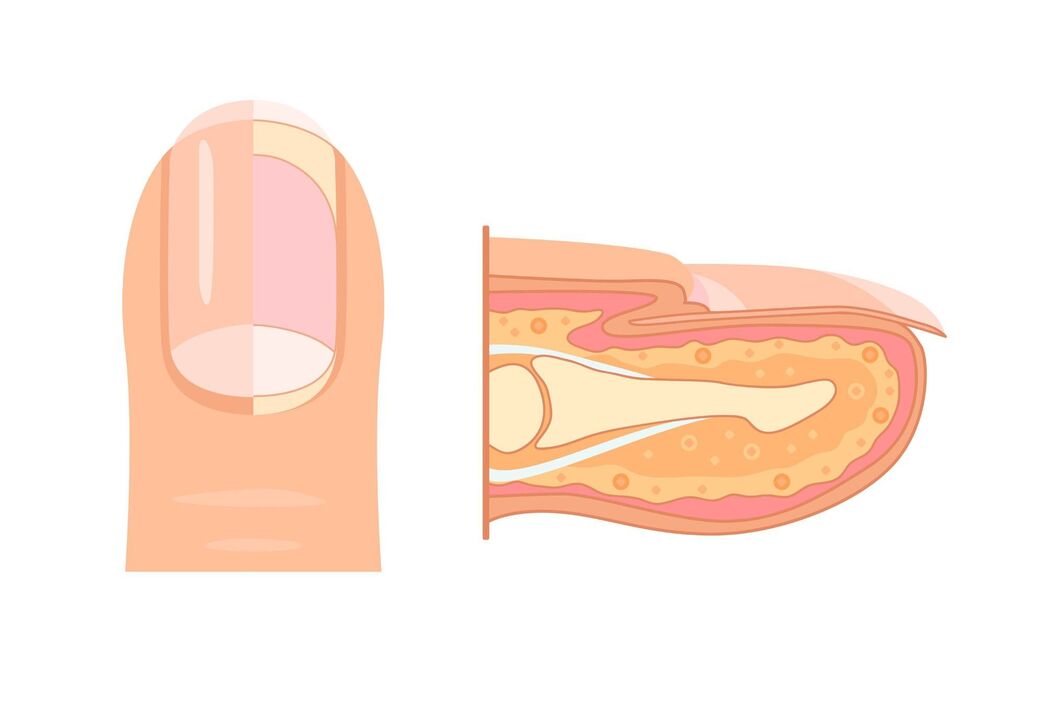
Symptoms of nail fungus
As onychomycosis progresses, its symptoms become more pronounced.
Main symptoms of nail fungus:
- change the color of the nail plate to yellow, black, green, brown or gray;
- separate the nail plate from the bed;
- change the thickness of the nail plate;
- koilonychia - the nail becomes concave, teaspoon-shaped;
- Onychomycosis - nails bend like the beak of a bird of prey;
- nail bed thickening;
- changes on the surface of the nail plate: formation of pits, grooves, ridges;
- nail fold inflammation.
Complications of nail fungus
If left untreated, onychomycosis in diabetics can lead to serious complications, such as diabetic foot - soft tissue ulcerative defects that lead to damage to tendons and bone structures.
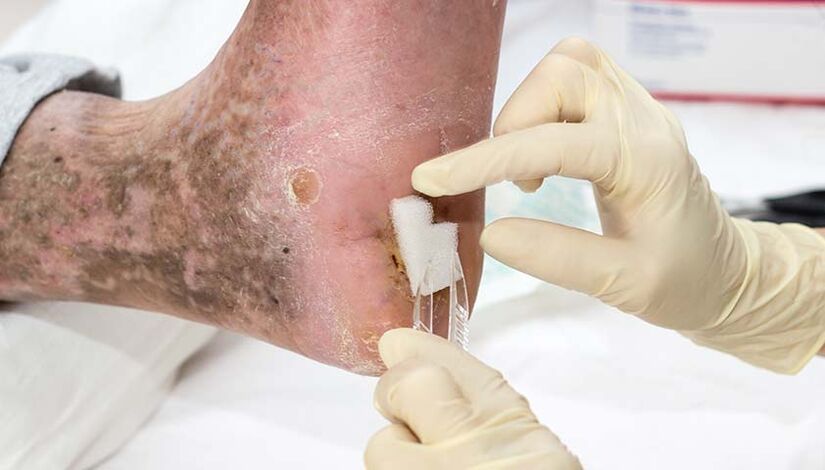
In people with long-term fungal infections, as well as in immunocompromised states, onychomycosis can lead to severe allergic reactions. This is explained by the fact that the fungal colony and its metabolic products act as sensitizers - agents that cause the body to react with increased sensitivity.
As a result, an allergic reaction is formed, which can have various manifestations: exacerbation of bronchial asthma, the appearance of bacterial eczema foci and the development of urticaria.
Common complications of nail fungus:
- diabetic foot;
- allergic reaction;
- Chronic halos on the extremities are a contagious skin lesion;
- lymphangiogenesis - retention of lymphatic fluid in tissues;
- Elephantiasis (elephantema, elephantiasis) is a condition of lymphedema that progresses concurrently with the replacement of subcutaneous adipose tissue with connective tissue.
Diagnosis of nail fungus
Diagnosis and treatment of onychomycosis is performed by a dermatologist. During the examination, the doctor will evaluate the condition of the patient's nails, skin, mucous membranes and hair. He will perform dermoscopy and examine the skin under magnification. Along with the examination, the specialist will collect medical history and ask the patient about lifestyle, nutritional quality, living habits and family care procedures. If you suspect nail fungus, your doctor will order tests. Examination of the nail plate for scratches will rule out or confirm a fungal infection. The doctor may also refer the patient for microscopic examination and culture.
Diabetes can worsen the course of onychomycosis and lead to serious complications. Complex studies can rule out or confirm this diagnosis. A complete blood count helps evaluate the patient's general condition.
Treatment of nail fungus
Treatment of onychomycosis can be local, systemic or combined. Remedial therapy may also be required, aimed at eliminating comorbidities. In topical therapy, antifungal medication is applied directly to the nail plate and nail folds. In this case, the drug concentrates on the surface of the nail and does not penetrate into the blood, eliminating the risk of side effects.
However, with topical therapy, the medication is not always able to reach the fungal population, especially if it is deep in the nail bed. Before applying the topical medication, the affected nail must be cut off. At home, you can use keratolytic paste - it contains a small amount of acid and can soften the nails.
Systemic therapy allows the antifungal agent to enter the affected area through the blood, no matter how deep the fungal colony is hidden.
The main systemic drugs for the treatment of onychomycosis:
- antifungal drugs;
- antiseptic - has both antifungal and antibacterial effects;
- Multi-ingredient medications may also contain anti-inflammatory agents.
The treatment regimen and dosage of the drug are determined by the doctor. In combination therapy, systemic and local treatments are performed simultaneously. This allows you to increase the effectiveness of treatment and shorten treatment time.
Remedial therapy is aimed at treating concomitant diseases that can complicate the course of onychomycosis. These are mainly diabetes mellitus, thyroid pathology and vascular diseases (for example, varicose veins). Treatment tactics are determined by the doctor and other specialist specialists, who in this case manage the patient together.
Forecasting and prevention
If you consult a doctor in time, the prognosis of onychomycosis is favorable: up to 80% of patients treated with antifungal drugs will recover from the disease forever. To prevent nail fungus, you need to protect your feet and hands from factors that cause irritation and injury, and strengthen your immune system.
Measures to prevent nail fungus:
- Change your socks every day or more often if your feet are sweaty or wet;
- Dry or dry shoes after wearing;
- Do not wear shared sandals when visiting;
- Do not try on shoes in the store barefoot;
- Use a personal towel to wipe your feet;
- Use separate tools for nail care (tweezers, files);
- wear shoes in swimming pools or saunas;
- monitor the variety of your diet;
- Avoid stressful situations.

























